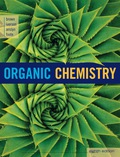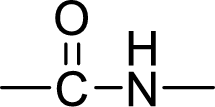
Organic Chemistry
8th Edition
ISBN: 9781337516402
Author: Brown
Publisher: Cengage
expand_more
expand_more
format_list_bulleted
Concept explainers
Question
Chapter 18, Problem 18.59P
Interpretation Introduction
Interpretation:
The amide formation between the given combination of dicarboxylic acid and diamine will lead to the formation of a polymer has to be shown.
Concept introduction:
Polyamides:
It is a family of
An amide linkage is shown below:

Kevlar has a similar structure to nylon-6,6. It differ in a way that the amide link joins benzene rings in Kevlar whereas carbon atoms are joined together by amide bonds in nylon-6,6.
Expert Solution & Answer
Want to see the full answer?
Check out a sample textbook solution
Students have asked these similar questions
H
NH₂
ཡིནྣཾ ༥ ཨ ཨནྡྷ༥ ༠ ཨི་ཝཱ, ཙ ཨ་ར༩
H
NH3+
the acidity of the amine ion drives the reaction to shift toward the conjugate base of the carboxylic acid product.
the resulting carboxylic acid ion is a weaker base than an acetate ion.
O aldehydes are more reactive toward nucleophiles than ketones.
Onucleophilic attack occurs preferentially at the less hindered carbon of the formyl group.
Q4:- Draw structures, give names, and classify as primary, secondary, or tertiary amine :
the eight isomeric amines of formula CaHi.N
Q5:- Give structures and names of the principal organic reactants and products of the following reactions.
a- conversion of Carboxylic Acids into Esters
b- Hydrolysis of nitrites.
c- Hofmann degradation of amides
Q6:- Arrange the compounds of each set in order of basicity ? Explain your choice.
ethylamine, 2-aminoethanol, 3-amino-l-propanol
Can 3-hexanol be easily made from hexanoic acid via reduction why or why not
when trying to oxidize a primary alcohol to an aldehyde, why do you have to carefully choose your oxidizing agent and/or reaction conditions? Why is this not an issue in biological organism?
Fully describe why amines are based in organic chemistry
Chapter 18 Solutions
Organic Chemistry
Ch. 18.1 - Prob. 18.1PCh. 18.2 - Prob. 18.2PCh. 18.4 - Prob. 18.3PCh. 18.4 - Prob. 18.4PCh. 18.4 - Synthesis of nitriles by nucleophilic displacement...Ch. 18.5 - Complete the following transesterification...Ch. 18.6 - Complete and balance equations for the following...Ch. 18.8 - Prob. AQCh. 18.8 - Several compounds have been found to inhibit...Ch. 18.8 - Prob. CQ
Ch. 18.8 - The following sequence of steps is used to create...Ch. 18.9 - Prob. 18.8PCh. 18.9 - Prob. 18.9PCh. 18.10 - Prob. 18.10PCh. 18.10 - Show how to convert (R)-2-phenylpropanoic acid to...Ch. 18 - Prob. 18.12PCh. 18 - Write the IUPAC name for each compound. (a)...Ch. 18 - Prob. 18.14PCh. 18 - Prob. 18.15PCh. 18 - Propose a structural formula for compound A,...Ch. 18 - Propose a structural formula for compound B,...Ch. 18 - Propose a structural formula for each compound...Ch. 18 - Draw a structural formula for the principal...Ch. 18 - Prob. 18.20PCh. 18 - Prob. 18.21PCh. 18 - Prob. 18.22PCh. 18 - Prob. 18.23PCh. 18 - Prob. 18.24PCh. 18 - Show the product expected when the following...Ch. 18 - The reagent diisobutylaluminum hydride (DIBALH)...Ch. 18 - Prob. 18.27PCh. 18 - Prob. 18.28PCh. 18 - Prob. 18.29PCh. 18 - Nicotinic acid, more commonly named niacin, is one...Ch. 18 - Prob. 18.31PCh. 18 - Prob. 18.32PCh. 18 - Prob. 18.33PCh. 18 - Prob. 18.34PCh. 18 - Prob. 18.35PCh. 18 - Isoniazid, a drug used to treat tuberculosis, is...Ch. 18 - Prob. 18.37PCh. 18 - A step in a synthesis of PGE1 (prostaglandin E1,...Ch. 18 - Prob. 18.39PCh. 18 - Prob. 18.40PCh. 18 - Show how to synthesize 5-nonanone from...Ch. 18 - Prob. 18.42PCh. 18 - The following sequence of steps converts...Ch. 18 - Prob. 18.44PCh. 18 - Prob. 18.45PCh. 18 - Prob. 18.46PCh. 18 - Prob. 18.47PCh. 18 - Following is a retrosynthetic analysis for the...Ch. 18 - Prob. 18.50PCh. 18 - Given this retrosynthetic analysis, propose a...Ch. 18 - Prob. 18.52PCh. 18 - Prob. 18.53PCh. 18 - Prob. 18.54PCh. 18 - In Problem 7.28, we saw this step in Johnsons...Ch. 18 - Prob. 18.56PCh. 18 - Prob. 18.57PCh. 18 - Prob. 18.58PCh. 18 - Prob. 18.59PCh. 18 - Prob. 18.60PCh. 18 - Prob. 18.61PCh. 18 - Prob. 18.62PCh. 18 - Using your reaction roadmap as a guide, show how...Ch. 18 - Using your reaction roadmap as a guide, show how...Ch. 18 - Using your reaction roadmap as a guide, show how...Ch. 18 - Using your reaction roadmap as a guide, show how...Ch. 18 - Minoxidil is a molecule that causes hair growth in...Ch. 18 - Prob. 18.69PCh. 18 - Prob. 18.70PCh. 18 - Prob. 18.71P
Knowledge Booster
Learn more about
Need a deep-dive on the concept behind this application? Look no further. Learn more about this topic, chemistry and related others by exploring similar questions and additional content below.Similar questions
- Consider the following compounds: Compound E: benzoic acid Compound F: benzoyl chloride Compound G: benzamide Compound H: benzaldehyde a) Identify the compound can be oxidised into compound E. b) Select one compound that can undergo alcoholysis to yield an ester. c) Select two compounds which áre known as carboxylic acid derivatives.arrow_forwardWe have studied Fischer esterification, in which a carboxylic acid is reacted with an alcohol in the presence of an acid catalyst to form an ester. Suppose that you start instead with a dicarboxylic acid such as terephthalic acid and a diol such as ethylene glycol. Show how Fischer esterification in this case can lead to a macromolecule with a molecular weight several thousand times that of the starting materials. HO, OH poly(ethylene terephthalate) (РET) НО HO, 1,4-Benzenedicarboxylic acid (Terephthalic acid) 1,2-Ethanediol (Ethylene glycol) the material produced in this reaction is a high- molecular-weight polymer, which can be fabricated into Mylar films and into the textile fiber known as Dacron polyester.arrow_forwardWhen reacting an acid halide with amines, it is necessary to use at least two moles of the amine because: A) Acid halides are so unreactive that two moles of the attacking nucleophile are needed B) Using one mole of the amine leads to a neutralization reaction between the two reactants C) Excess amine is needed to react with the hydrohalic acid produced D) The second mole of amine is needed for deprotonation.arrow_forward
- 1) Nitriles are typically hydrolyzed to form what class of compounds? 2) what must one keep in mind when performing the hydrolysis of a nitrile to a carboxylic acid? 3) why are nitriles over-looked as carboxylic acid derivatives?arrow_forwardIn biochemical reactions, decarboxylation of carboxylic acids typically takes place for-keto carboxylic acids. Justify a rational why nature opted for-keto carboxylic acid decarboxylation. Among the following types of biochemical reactions, ester hydrolysis, rearrangement reactions, water elimination reactions, and anhydride hydrolyses, which one is the most favorable one. Rank the above reactions types in the order of being the most to least favorable reactionarrow_forwardCarboxylic acids can also react with amides to give polyamides (polymers). The same is true with esters and alcohols. Read on lactomer and how it is used for stitches that can dissolve overtime. Why do lactomer stitches dissolve within 2 to 3 weeks following surgery? Refer to the photo below.arrow_forward
- Chapter 1 (Carbonyl compounds I) Explain how the class I carbonyl compound reacts? What will be the product when ethylamine and propyl amine reacts with acetyl chloride? Why only one amide obtained after the reaction of acetyl chloride with a mixture of ethylamine and trimethylamine? Excess amine is required in the reaction of acetyl chloride with amine whereas excess alcohol is not required in the reaction of acetyl chloride and alcohol. Why? List the following ester in order of decreasing reactivities towards hydrolysis with reason: Methyl benzoate, p-nitro methyl benzoate and p-methoxy methyl benzoate The reaction of an ester with an amine is not as slow as the reaction of an ester with water or an alcohol. Explain with reason. Explain why the rate of aminolysis of an ester cannot be increased by H+, OH- or OR-. How can you activate the carboxylic acid? Is acid catalyzed hydrolysis of acetamide a reversible or an irreversible reaction. Explain. Chapter 2 (Carbonyl compounds II)…arrow_forwardTwo reactions occur when sodium hydroxide is added to methyl salicylate. One is immediate and one only occurs with reflux over time. What type of reaction occurs immediately and with which functional group on methyl salicylate does it react? What type of reaction occurs with reflux over time and with which functional group on methyl salicylate does it react?arrow_forwardEthyl acetate Ethyl benzoate Ethyl butanoate Ethyl cinnamate Ethyl decanoate Ester Odours of Various Esters Odour Glue/fruit Fruit Pineapple/roses (peach) Honey, peach Grape Rum Pineapple, banana Ethyl formiate Ethyl hexanoate Ethyl isobutanoate Apple Ethyl isopropionate Apple Ethyl isovalerate Apple Ethyl phenylacetate Honey Ethyl propionate Strawberry Ethyl salicylate Methyl acetate Methyl anthranilate Methyl benzoate Methyl butanoate Methyl heptanoate Methyl isobutanoate Methyl isopropionate Methyl phenylacetate Wintergreen (mint) Berries Grape Fruit Apple, banana Berries, iris Apple, pineapple, apricot Apple Honey, jasmine Berries, rum Wintergreen (mint) Methyl propionate Methyl salicylate Pentyl acetate Banana, pear (honey) Pentyl butanoate Apricot Octyl acetate Orange Isopentyl acetate Banana Benzyl acetate Jasmine Butyl butanoate Pineapple Isobutyl acetate Isobutyl propionate Isopentyl propionate Isopentyl acetate Raspberry Rum Pineapple Orangearrow_forward
- Predict the products formed when cyclohexanone reacts with the following reagents.) hydroxylamine and weak acidarrow_forwardPropose a method to separate a mixture containing phenol, benzoic acid, naphthalene, and p-nitroaniline. Phenol is soluble in sodium hydroxide solution but insoluble in neutral water or sodium bicarbonate solution. Benzoic acid is soluble in either sodium hydroxide or sodium bicarbonate solutions. Write out the structures of the molecules in your scheme.arrow_forwardWhy do you wash the dichloromethane solution of your reductive amination product with sodium bicarbonate, rather than dilute aqueous HCl? a) Sodium bicarbonate is a good method of removing aldehydes from organic solvent.b) The amine product will be protonated by acid and remain in the aqueous layer as a salt.c) Sodium bicarbonate transfers the amine starting material into the aqueous layer.d) Sodium bicarbonate reacts with leftover NaBH(OAc)3 and removes it from the mixture.arrow_forward
arrow_back_ios
SEE MORE QUESTIONS
arrow_forward_ios
Recommended textbooks for you
 Organic ChemistryChemistryISBN:9781305580350Author:William H. Brown, Brent L. Iverson, Eric Anslyn, Christopher S. FootePublisher:Cengage Learning
Organic ChemistryChemistryISBN:9781305580350Author:William H. Brown, Brent L. Iverson, Eric Anslyn, Christopher S. FootePublisher:Cengage Learning Introduction to General, Organic and BiochemistryChemistryISBN:9781285869759Author:Frederick A. Bettelheim, William H. Brown, Mary K. Campbell, Shawn O. Farrell, Omar TorresPublisher:Cengage Learning
Introduction to General, Organic and BiochemistryChemistryISBN:9781285869759Author:Frederick A. Bettelheim, William H. Brown, Mary K. Campbell, Shawn O. Farrell, Omar TorresPublisher:Cengage Learning Chemistry for Today: General, Organic, and Bioche...ChemistryISBN:9781305960060Author:Spencer L. Seager, Michael R. Slabaugh, Maren S. HansenPublisher:Cengage Learning
Chemistry for Today: General, Organic, and Bioche...ChemistryISBN:9781305960060Author:Spencer L. Seager, Michael R. Slabaugh, Maren S. HansenPublisher:Cengage Learning Chemistry: The Molecular ScienceChemistryISBN:9781285199047Author:John W. Moore, Conrad L. StanitskiPublisher:Cengage Learning
Chemistry: The Molecular ScienceChemistryISBN:9781285199047Author:John W. Moore, Conrad L. StanitskiPublisher:Cengage Learning Organic And Biological ChemistryChemistryISBN:9781305081079Author:STOKER, H. Stephen (howard Stephen)Publisher:Cengage Learning,
Organic And Biological ChemistryChemistryISBN:9781305081079Author:STOKER, H. Stephen (howard Stephen)Publisher:Cengage Learning, General, Organic, and Biological ChemistryChemistryISBN:9781285853918Author:H. Stephen StokerPublisher:Cengage Learning
General, Organic, and Biological ChemistryChemistryISBN:9781285853918Author:H. Stephen StokerPublisher:Cengage Learning

Organic Chemistry
Chemistry
ISBN:9781305580350
Author:William H. Brown, Brent L. Iverson, Eric Anslyn, Christopher S. Foote
Publisher:Cengage Learning

Introduction to General, Organic and Biochemistry
Chemistry
ISBN:9781285869759
Author:Frederick A. Bettelheim, William H. Brown, Mary K. Campbell, Shawn O. Farrell, Omar Torres
Publisher:Cengage Learning

Chemistry for Today: General, Organic, and Bioche...
Chemistry
ISBN:9781305960060
Author:Spencer L. Seager, Michael R. Slabaugh, Maren S. Hansen
Publisher:Cengage Learning

Chemistry: The Molecular Science
Chemistry
ISBN:9781285199047
Author:John W. Moore, Conrad L. Stanitski
Publisher:Cengage Learning

Organic And Biological Chemistry
Chemistry
ISBN:9781305081079
Author:STOKER, H. Stephen (howard Stephen)
Publisher:Cengage Learning,

General, Organic, and Biological Chemistry
Chemistry
ISBN:9781285853918
Author:H. Stephen Stoker
Publisher:Cengage Learning